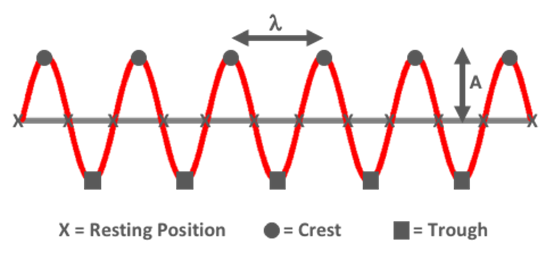Frequency and Period
A wave can be described by five different properties. Two of these properties are temporal or time-based properties; these are frequency and period. Frequency and period are used to describe the vibrations of individual particles in the medium. As a wave passes through a medium (i.e., through a material), the particles of the medium begin to vibrate about a fixed position. The frequency of their vibrations describes how often particles complete a full vibration. Mathematically, this is defined as the number of back and forth vibrations per unit of time. Given this definition, one would reason that the quantity frequency is expressed in units of vibrations per second. This is often shortened to "per second" and represented by the unit Hertz (abbreviated Hz). The frequency of any wave can be determined by counting the number of full vibrational cycles of a particle in the medium over the course of some period of time. Once done, the ratio of the number of vibrations to time can be calculated; this yields the frequency.
Period is the other time-based wave property. It is closely related to the frequency. While frequency describes how often particles vibrate about their fixed position, the period describes how much time it takes a particle to complete a full vibration. In other words, period is the time it takes for a particle to complete a full vibrational cycle. Being a time, period is often represented by the symbol T (capital letter T) and is expressed in a unit of time such as a second. The period of any wave can be determined by counting the number of full vibrational cycles of a particle in the medium over the course of some period of time. Once done, the ratio of the time to the number of vibrations can be calculated; this yields the period. If you contrast this with the means of determining the frequency, you will note that the period is the reciprocal of the frequency.
Wavelength and Amplitude
While the frequency and period are temporal (time-based) properties of waves, the wavelength and the amplitude are spatial properties (distance-based). As a transverse wave is passing through a medium, the particles of the medium (perhaps the coils of a snakey) are vibrating. If a snapshot of the medium were taken at some moment in time, you would observe that the medium assumes the familiar sinusoidal shape of a wave.

In the snapshot, there would be points along the snakey that are displaced a maximum distance from the usual resting position of the snakey. Measuring the distance that such a particle is displaced from the resting position provides a measurement of the amplitude of the wave. You might say that the amplitude is the vertical distance from rest to crest. It describes the maximum amount of displacement that a particle will vibrate from its usual resting position. You might think of it as how high above rest that a particle vibrates. This distance is denoted by the symbol A in the diagram above. Being a distance, the unit of amplitude is a distance unit such as centimeter or meter.
In the same snapshot, you would notice that there is a repeating pattern that repeats itself over and over again. You might describe the repeating pattern as consisting of a resting point-crest-resting point-trough-resting point ... repeat. This repeating unit is a "wave". And the length of this repeating unit is known as the wavelength. Naturally, wavelength describes how long the wave is. A useful way to remember this is to remember it as the distance from one crest of the wave pattern to the next adjacent crest of the pattern. While this is useful, you should remind yourself that wavelength is simply the length of the wave and as such it can also be related to the distance from trough to trought. The symbol most commonly used to describe the length of a wave is a lower case Greek letter: lambda. It looks like this: λ. Like amplitude, wavelength is described by a distance unit such as centimeter or meter.
Wave Speed
The speed of a wave takes into account both spatial and temporal properties. In other words, it considers both space (distance) and time in its definition. Simply put, wave speed describes how fast the wave moves from one location to another. More technically, it describes the distance traveled (a spatial feature) per unit of time (a temporal feature). Given this as its definition, wave speed would have units equivalent to a distance unit divided by a time unit. The most common example of such a unit is meter/second. Because the speed of a wave is often referred to as the velocity, the symbol used to represent it is the symbol v.
